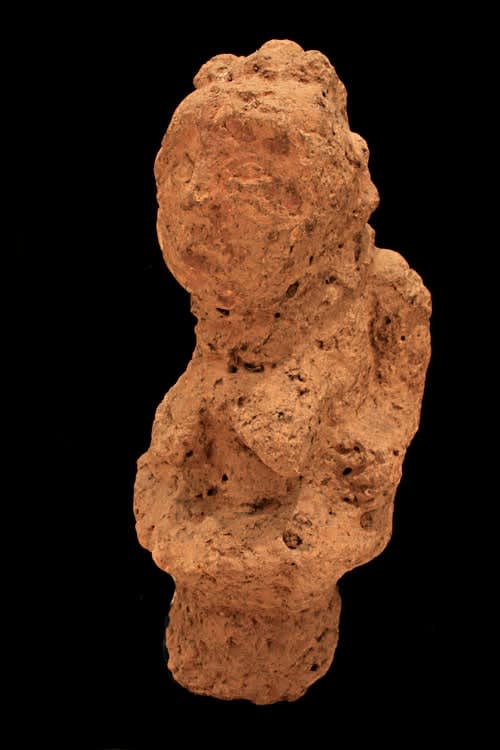Bongo Stone Effigy Figure, 1000 BCE - 1000 CE
Stone
24
SUD.008 (LSO)
This outstanding stone sculpture of a human figure is both very old and highly inscrutable. It is also one of the most exceptional examples we have seen. The body is...
This outstanding stone sculpture of a human figure is both very old and highly inscrutable. It is also one of the most exceptional examples we have seen. The body is comparatively naturalistic, and much less reduced than in others of this group. The base of the piece appears to be a stool, and as it is highly eroded it is not possible to see how the figure’s legs related to the seat. The figure may be female, judging from what appear to be breasts. The head is a masterwork, with delicate rendering of rimmed eyes, a small nose, modelled cheeks and an ornate crested coiffure. The irregular condition and weathering of the stone, which is extremely hard, implies that it is ancient, and that it has been buried for a long period of time.
The sculpture strongly resembles Palaeolithic works from Europe and Asia Minor, which are preoccupied with “fertility” symbolism that usually revolves around corpulent, schematically simplified women with highly exaggerated breasts and buttocks. This and other related pieces in the Barakat collection have been classified as Bongo, but there are issues with this classification. The Bongo are linguistically, historically and archaeologically attested to have come to Sudan from the area currently known as Chad during the 16th century, thus post-dating this piece by between 500 and 2000 years. We are thus talking about an unexplored culture. The similarities in style with Bongo art may be coincidence, but it is more probable that the Bongo people acquired their distinctive art styles from the previous inhabitants of the area in the manner of the Dogon and the Tellem.
As stated, nothing is known of this culture. Even the age of the piece is uncertain: the span we have provided is inevitably wide, and while it is most likely to lie within the first millennium BC to the first millennium AD, it may be older than this. The Bura (Niger Delta) made similarly reductivist stone pieces in the first half of the second millennium AD. The art itself does imply a society of considerable complexity, and thus settled, agricultural and socially stratified. The function of the piece is unknowable at present. However, the size of the object exceeds that which might be expected for personal talismanic functions, and is more likely to be a social/religious focus that represents an ancestor either real or mythical.
This is a rare and fascinating piece of ancient African art.
The sculpture strongly resembles Palaeolithic works from Europe and Asia Minor, which are preoccupied with “fertility” symbolism that usually revolves around corpulent, schematically simplified women with highly exaggerated breasts and buttocks. This and other related pieces in the Barakat collection have been classified as Bongo, but there are issues with this classification. The Bongo are linguistically, historically and archaeologically attested to have come to Sudan from the area currently known as Chad during the 16th century, thus post-dating this piece by between 500 and 2000 years. We are thus talking about an unexplored culture. The similarities in style with Bongo art may be coincidence, but it is more probable that the Bongo people acquired their distinctive art styles from the previous inhabitants of the area in the manner of the Dogon and the Tellem.
As stated, nothing is known of this culture. Even the age of the piece is uncertain: the span we have provided is inevitably wide, and while it is most likely to lie within the first millennium BC to the first millennium AD, it may be older than this. The Bura (Niger Delta) made similarly reductivist stone pieces in the first half of the second millennium AD. The art itself does imply a society of considerable complexity, and thus settled, agricultural and socially stratified. The function of the piece is unknowable at present. However, the size of the object exceeds that which might be expected for personal talismanic functions, and is more likely to be a social/religious focus that represents an ancestor either real or mythical.
This is a rare and fascinating piece of ancient African art.
